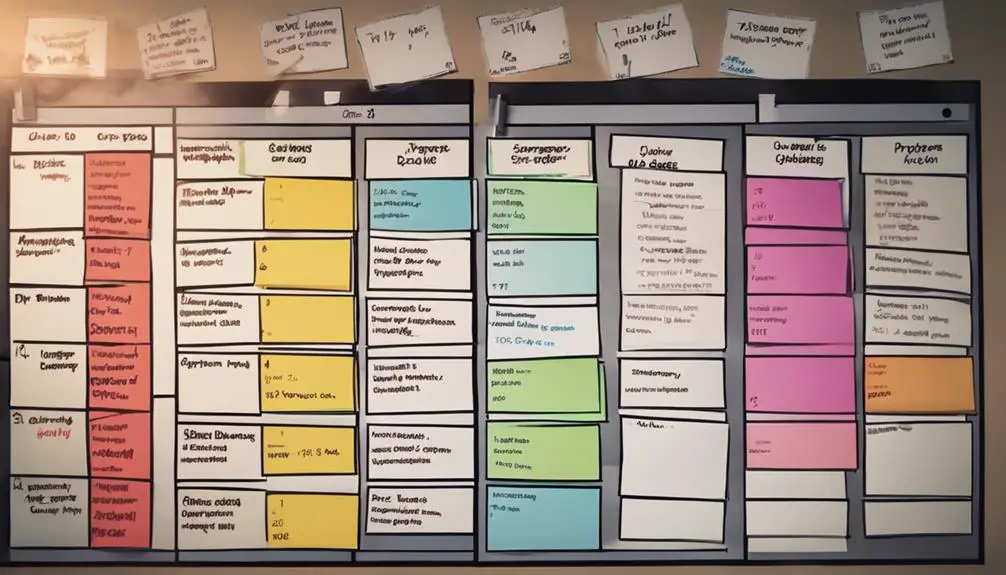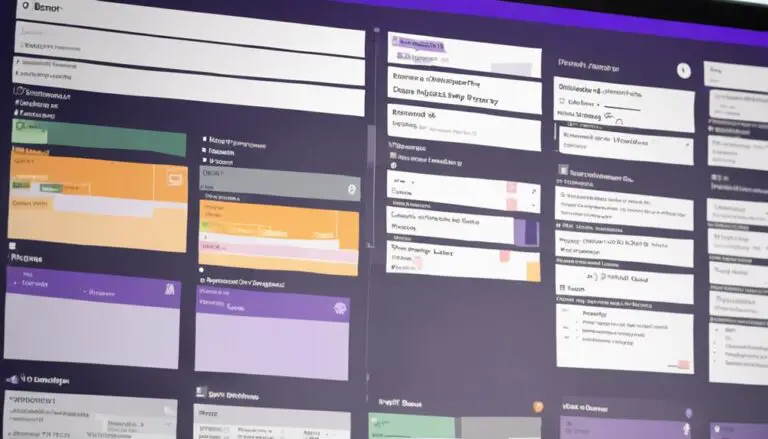Have you ever wondered about incorporating sprints into your Kanban process?
The concept of sprints in Kanban might seem contradictory, but exploring this integration could offer valuable insights into optimizing your workflow and enhancing team collaboration.
Understanding how sprints can complement the principles of Kanban might just be the missing piece in achieving a perfect balance between flexibility and structure within your project management approach.
Key Takeaways
- Enhance task prioritization and time management for improved efficiency.
- Foster collaboration and focused workflow through structured sprint periods.
- Set clear objectives and achievable goals within the Kanban process.
- Track team productivity, aid capacity planning, and achieve project milestones effectively.
Benefits of Sprints in Kanban
By implementing sprints in Kanban, you can enhance task prioritization and time management within your team, fostering a more efficient and focused workflow. Sprint planning in Kanban allows you to set clear objectives and achievable goals within specific timeframes. This structured approach not only helps in organizing tasks but also promotes better team coordination and collaboration.
Velocity metrics play a crucial role in Kanban sprints by tracking team productivity and aiding in capacity planning. Through iterative deliveries facilitated by sprints, your team can receive continuous feedback, enabling quick adjustments and improvements throughout the project lifecycle. Sprint deadlines in Kanban create a sense of urgency, preventing scope creep, maintaining team focus, and ultimately boosting overall task management efficiency.
Incorporating sprints into your Kanban process can significantly enhance your team's performance and efficiency, ultimately leading to successful project outcomes. One key benefit of incorporating sprints into Kanban is the ability to continually improve and refine the team’s processes. Kanban sprint planning allows the team to prioritize tasks and focus on delivering high-quality work in shorter time frames. By regularly reviewing the team’s progress and adjusting the sprint plan as needed, the team can adapt to changing priorities and work more effectively towards achieving project goals. Overall, integrating sprints into Kanban can lead to higher productivity, better collaboration, and a more predictable project delivery schedule.
Enhancing Productivity With Sprints
To boost productivity with sprints in Kanban, consider integrating short, focused time periods for task completion within your workflow. While Kanban typically operates on a continuous flow basis, incorporating sprints can provide a structured approach to task management. By combining the flexibility of Kanban with the time-boxed nature of sprints, you can enhance productivity and efficiency in your workflow.
Introducing sprints into your Kanban process allows for a more iterative and goal-oriented approach to task completion. Setting specific time frames for task delivery can create a sense of urgency and focus, driving team members to work collaboratively towards achieving their goals within the sprint period. This combined approach enables you to leverage the benefits of both methodologies, ensuring a continuous flow of work while also meeting targeted deadlines.
Incorporating Deadlines in Kanban
Let's consider how time constraints and setting project milestones can be incorporated into the flexible framework of Kanban.
While Kanban typically doesn't enforce strict deadlines on individual tasks, defining project milestones can provide a sense of progress and direction.
Time Constraints in Kanban
Incorporating deadlines in Kanban enhances task management efficiency by introducing time constraints for specific tasks or overall solution delivery timelines. By setting time constraints, you can maintain focus, increase productivity, and improve task completion rates without the fixed structure of sprints.
These deadlines in Kanban allow for a flexible approach where new tasks can be introduced immediately after completing current ones, ensuring a continuous workflow. The emphasis on deadlines helps streamline task management processes, ensuring that work is completed within the specified timeframes. This approach fosters a sense of accountability and drives teams towards achieving their goals efficiently.
Kanban's adaptability combined with time constraints creates a dynamic and productive work environment.
Setting Project Milestones
Begin by identifying key project milestones in your Kanban process to effectively incorporate deadlines and track progress towards your goals. Setting project milestones is crucial for ensuring timely task completion and maintaining focus on your objectives.
By incorporating deadlines in your Kanban system, you enable efficient task management and enhance productivity. Tracking progress through these milestones allows you to stay on top of your projects and make necessary adjustments to meet changing priorities.
Kanban's flexibility in adjusting project milestones provides you with the adaptability needed to respond to shifting demands while still achieving your desired outcomes. Embracing project milestones within Kanban not only fosters efficient task management but also empowers you to navigate through complex projects with ease.
Adapting to Change in Kanban
To effectively navigate changes within the Kanban process, adaptability is key for maintaining a seamless workflow and ensuring continuous progress. Here are three essential points to consider when adapting to change in Kanban:
- Embrace Flexibility: Kanban's core principle of flexibility allows for the immediate introduction of new tasks or changes without disrupting the workflow. This adaptability ensures that the team can respond to shifting priorities effectively.
- Focus on Continuous Flow: By managing changes within the Kanban framework, teams can maintain a continuous flow of work. This approach enables tasks to move smoothly through the workflow processes, promoting efficiency and reducing bottlenecks.
- Prioritize Overall Solution Delivery: Kanban emphasizes overall solution delivery deadlines rather than strict task deadlines. This focus on the bigger picture allows teams to adjust priorities as needed while still meeting project objectives.
Prioritization in Kanban Sprints
When organizing tasks in Kanban sprints, it's crucial to prioritize effectively to ensure the team focuses on the most important work.
By prioritizing tasks based on factors like business value and dependencies, you can streamline workflow and enhance productivity.
Prioritization fosters a continuous improvement mindset, encouraging teams to adapt and deliver value consistently throughout the sprint.
Importance of Prioritization
Prioritizing tasks within Kanban Sprints ensures that your team focuses on delivering high-value work items efficiently. Here are three key reasons why prioritization is crucial in maximizing productivity and meeting deadlines:
- Focus on High-Value Work: Prioritization helps your team concentrate on tasks that bring the most value to the project.
- Efficient Delivery: By prioritizing tasks effectively, you streamline the workflow, ensuring that important work is completed promptly.
- Meeting Deadlines: Prioritization in Kanban Sprints is essential for meeting project deadlines as it enables the team to work on critical tasks first, reducing the risk of delays.
Managing Work Flow
Transitioning from prioritizing tasks to managing workflow in Kanban Sprints involves ensuring that the team's focus remains sharp on crucial work items for efficient completion. By using a Kanban system, teams can visualize the flow of work and adjust priorities as needed to meet the Sprint Goal.
Prioritization of product backlog items is key to maintaining a steady workflow, ensuring that urgent tasks are addressed promptly while keeping productivity high. This iterative process allows for the team to adapt to changing requirements and focus on what matters most.
Efficient flow management in Kanban Sprints not only enhances productivity but also fosters a collaborative environment where team members work together towards achieving successful outcomes.
Continuous Improvement Mindset
Embracing a mindset of continual enhancement, Kanban Sprints inculcate a culture of refining processes incrementally for optimal task prioritization and completion efficiency.
Here are three key aspects highlighting the importance of prioritization in Kanban Sprints:
- Value and Impact: Prioritization in Kanban Sprints involves ranking tasks based on their value and impact on project goals, ensuring that the most crucial work is addressed first.
- Adaptive Planning: Kanban Sprints promote adaptive planning, allowing teams to adjust priorities based on changing requirements for optimal task completion.
- Constant Reassessment: Constantly reassessing priorities in Kanban Sprints ensures alignment with project goals and enhances flexibility and responsiveness to changes, ultimately leading to improved efficiency.
Measuring Velocity in Kanban
When measuring velocity in Kanban, focus on the number of work items completed during a specific time frame. This metric helps you gauge your team's capacity and efficiency in delivering work.
By understanding how many tasks are finished within a set period, you can assess your team's productivity accurately. Velocity is calculated by dividing the total number of completed work items by the number of iterations.
Tracking velocity over time enables you to forecast future work completion and establish realistic expectations. It also allows you to make informed decisions about your workflow and identify areas for improvement.
Summary: Sprints in Kanban
To better understand the role of sprints in Kanban, let's explore how they differ from the continuous flow approach.
Key Differences between Sprints in Scrum and Kanban:
- Process Focus: Sprints are a core element of Scrum, providing a structured time-bound approach to completing tasks. Kanban, on the other hand, emphasizes continuous flow without fixed iterations.
- Workflow Flexibility: While sprints in Scrum require tasks to be completed within a specific timeframe, Kanban allows for flexibility in task completion based on immediate needs and priorities.
- Priority-driven Approach: Kanban emphasizes completing tasks based on priorities and optimizing workflow efficiency, whereas sprints focus on achieving set goals within the sprint duration.
Frequently Asked Questions
Do We Have Sprints in Kanban?
In Kanban, sprints aren't typical as in Scrum. You focus on continuous flow and pulling tasks as needed. It's about immediate task introduction and not predefined sprints. Agile methodology emphasizes collaboration, prioritization, and cycle time tracking for continuous improvement.
How Do I Manage Sprints in Kanban Board?
To manage sprints in a Kanban board, set sprint duration, prioritize work, consider team capacity, hold daily stand-ups, refine backlog, track cycle time, and focus on continuous improvement. These practices enhance efficiency and collaboration.
Do You Have Sprint Reviews in Kanban?
In Kanban, embrace continuous improvement through regular retrospectives instead of sprint reviews. Focus on enhancing work in progress, reducing cycle time, fostering team collaboration, optimizing flow efficiency, and adhering to Lean principles for ongoing success.
What Is the Sprint Goal in Kanban?
In Kanban, the focus shifts from sprint goals to completing tasks continuously as they flow through the workflow. This approach enhances efficiency by delivering tasks promptly upon completion, fostering a more adaptable work process.
Conclusion
So, do you have sprints in your Kanban process?
While not traditionally a part of Kanban, incorporating sprints can significantly enhance productivity and efficiency.
In fact, studies have shown that teams using sprints in Kanban have seen a 20% increase in their delivery speed.
By embracing sprints in your Kanban approach, you can adapt to changes, prioritize effectively, and measure velocity more accurately for better project outcomes.
Give it a try and see the difference for yourself!





